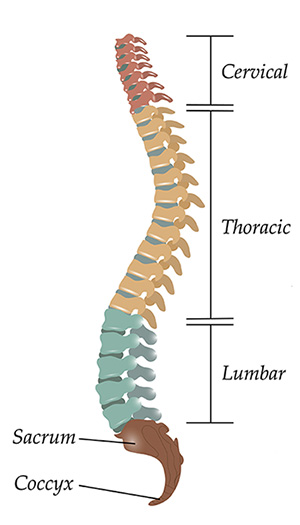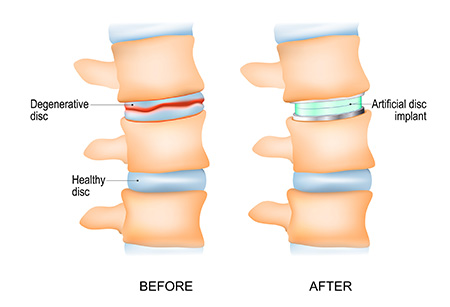Lumbar disc replacement
- Overview
- What is lumbar disc replacement?
- What is the difference between lumbar discectomy and lumbar disc replacement?
- What conditions does lumbar disc replacement treat?
- What are the benefits of artificial disc replacement?
- How to prepare for lumbar disc replacement surgery
- What happens during lumbar disc replacement surgery?
- Recovering from lumbar disc replacement
- Are there alternatives to lumbar disc replacement?
- Are there any risks to lumbar disc replacement surgery?
- Find your nearest hospital
- Ways to pay
- Contact us
Lumbar disc replacement is the replacement of a damaged or diseased disc in the spine, with an artificial disc to maintain movement in the treated spine area.
What is lumbar disc replacement?

Your spine is made up of a series of small bones called vertebrae, which are stacked on top of each other. Between each vertebra is an intervertebral disc, which acts as a cushion to absorb shock, provide stability, and allow movement of the spine.
When a disc is damaged or degenerates, it can tear or rupture trapping nerves and causing inflammation and pain.
Lumbar disc replacement is the replacement of a damaged or diseased disc in the spine, with an artificial disc to maintain movement in the treated spine area.
Lumbar refers to the lower back, though disc replacement can also be performed in other regions of the spine. Cervical disc replacement refers to disc replacement in the neck
What is the difference between lumbar discectomy and lumbar disc replacement?
A lumbar discectomy is a procedure to remove the part or all of a damaged disc, while a lumbar disc replacement involves removing the entire damaged disc and replacing it with an artificial disc that mimics the movement and cushioning of a natural disc.
What conditions does lumbar disc replacement treat?
Lumbar disc replacement is primarily used to treat conditions involving damage or degeneration of intervertebral discs in the spine, including:
- Degenerative disc disease (DDD) - This occurs when the intervertebral discs lose their flexibility, elasticity, and cushioning due to ageing or wear and tear. This can cause pain, stiffness, and loss of mobility.
- Herniated disc - A herniated disc happens when the inner gel-like core of the disc leaks through a tear in the outer layer, potentially compressing nearby nerves and causing pain, numbness, or weakness.
- Sciatica - A damaged disc in the lower back can compress the sciatic nerve, leading to pain that radiates down the legs, along with possible numbness and weakness.
- Spondylosis (spinal osteoarthritis) - This is a type of arthritis that affects the spine, often causing disc degeneration, bone spurs, and other degenerative changes that can lead to pain and stiffness.
- Chronic back pain - Chronic back pain originating from a damaged or degenerated intervertebral disc without significant nerve compression is known as discogenic back pain.
Your consultant will recommend lumbar disc replacement after reviewing your medical history, results from diagnostic tests such as X-rays and MRIs, and after non-surgical treatments have been explored.
What are the benefits of artificial disc replacement?
- Natural spinal movement: artificial disc replacement allows the spine to maintain its natural range of motion. Unlike spinal fusion, which fuses vertebrae and limits movement, artificial disc replacement replaces the damaged disc while preserving flexibility in the affected area.
- Pain relief: artificial disc replacement reduces pain in those with chronic back or neck pain.
- Less strain on other discs: Because artificial disc replacement maintains mobility in the treated area, there is less stress on the discs above and below the replacement, reducing the risk of adjacent segment degeneration.
- Faster recovery time: artificial disc replacement typically involves a less invasive procedure than spinal fusion, leading to shorter hospital stays and quicker recovery times.
How to prepare for lumbar disc replacement surgery
Your doctor and the hospital team will give you instructions on preparing for surgery, and it is important to follow them carefully. They will review your medical history, and you may be asked to complete some diagnostic tests such as X-rays, MRI and blood tests before your procedure.
Please tell your doctor and pre-assessment nurse about any medications you are taking, including prescription medications and supplements. Your healthcare professional team will let you know if can still take this before and after your surgery.
If you smoke, you will be asked to stop smoking for your surgery as smoking puts you at greater risk for wound infections and delays healing.
Follow any instructions for fasting before your surgery.
You will not be able to drive for 4 to 6 weeks after your surgery, so please arrange for someone to pick you up from the hospital and take you home.
What happens during lumbar disc replacement surgery?

During lumbar disc replacement surgery, you will be placed under general anaesthetic.
You will lie on your back, and your surgeon will make an incision in your abdomen. This approach allows for easier access to the spine while avoiding the need to cut through muscles or nerves.
Your surgeon will remove the damaged or degenerated disc and insert the artificial disc into the space between the vertebrae. After the artificial disc is in place, your surgeon closes the incision.
Recovering from lumbar disc replacement
You may need to stay in the hospital for a few days following surgery, depending on how well you recover. It is normal to feel some pain and discomfort after the surgery, but recovery is typically faster than other back surgeries as the bones do not need to heal or fuse.
As you recover, you will be encouraged to stand and walk as soon as possible. Your healthcare professional team will provide guidelines for activities and movements. You will also be taught physiotherapy exercises to help strengthen your spine and aid in your recovery.
Full recovery uses takes around 6 months, but many people can expect to return to normal activities within 3 months.
Are there alternatives to lumbar disc replacement?
- Spinal fusion surgery is a procedure to permanently connect two or more vertebrae in your spine. By fusing the vertebrae, the surgery restricts movement in the affected area, helping to stabilise the spine and reduce pain.
- Discectomy (or microdiscectomy) is a procedure to remove the part or all of a damaged disc. The vertebrae will then fuse on their own, or a spinal fusion may also be performed.
- Laminectomy involves removing part of the vertebra (lamina) and tissue to relieve pressure on the spinal cord or nerve.
- Lumbar decompression is a surgery to release trapped nerves in the lower (lumbar) spine.
- Stem cell therapy involves injecting stem cells into the damaged disc to encourage the regeneration of disc tissue and encourage healing.
- Non-surgical treatments, such as physical therapy, steroid injections, anti-inflammatory drugs (NSAIDs), and muscle relaxants may reduce and relieve pain.
Are there any risks to lumbar disc replacement surgery?
As with any surgery, lumbar disc replacement carries some risks. However, rest assured that your consultant will weigh up the risks and advantages with you when deciding if they recommend surgery.
Possible risks of lumbar disc replacement may include:
- Infection of the artificial disc or the area around it
- Implant loosening
- Dislocation of the artificial disc
- Stiffness or the spine
- Narrowing of the spine
- Nerve or spinal cord damage
Ways to pay
Nuffield Health promise
Our prices are all-inclusive. We will equal any comparable price. There are no time limits on your aftercare.
Paying for yourself
There are no hidden costs in our treatment prices. The price you see is the price you pay.
Find out morePersonal medical loan
Spread the cost of your treatment with a 10, 12 or 24 month 0% personal medical loan.
Find out moreMedical insurance
We work with you and your insurance provider to get you the treatment you need quickly
Find out more